|
Cedar Waxwings
There are ten photos on this page. As with our page on
Baltimore Orioles, although
most of our gallery pages are designed wherever possible to give
you an idea of how a bird of each species develops from nestling
to adult, this page tells three stories of this beautiful species.
The first story is how orphaned Cedar Waxwings grow when
raised at The Place for Wild Birds. The second story is how one
baby bird of this species came to us with a broken leg and was
healed, rehabilitated and eventually released. The third story
here is how we also achieve success helping injured adults, as
exemplified by one particularly lovely specimen.
Raising Orphans
Rehabilitating
a Cat-Attacked Nestling
Helping an Injured
Adult
Raising Orphans
(five photos)
1. Orphaned Cedar Waxwing,
very fat, mid-nestling
(We feed them well here!)
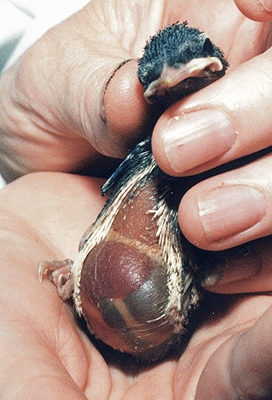 2. Orphaned Cedar Waxwing,
2. Orphaned Cedar Waxwing,
mid-nestling
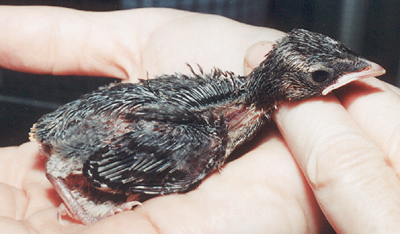 3. Late Nestling Cedar Waxwing
3. Late Nestling Cedar Waxwing
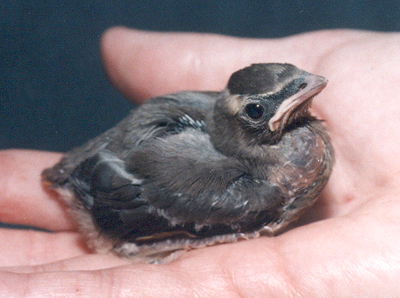 4. Fledgling Cedar Waxwing
4. Fledgling Cedar Waxwing
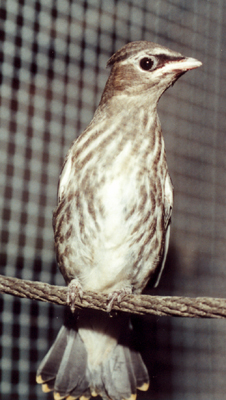 5. Juvenile Cedar Waxwings,
5. Juvenile Cedar Waxwings,
ready for release
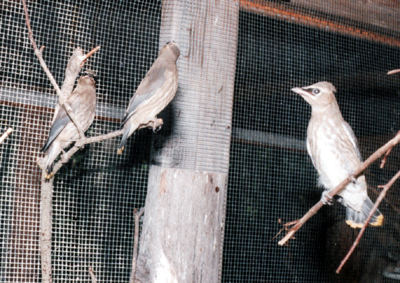

Rehabilitating a Cat-Attacked Nestling
(three photos and some text)
1. Cat-attacked Cedar Waxwing,
mid-nestling,
with a broken leg (an "open fracture") that has been
set
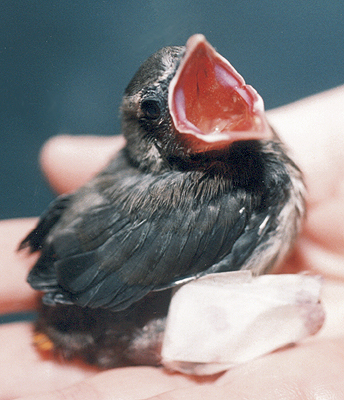 2. Cedar Waxwing,
2. Cedar Waxwing,
open leg fracture has healed,
wearing a foot brace
(Can you see the bump on the leg
where the bone has healed? This is a normal
development called a "healing callous,"
and eventually it will shrink down to nearly nothing.)
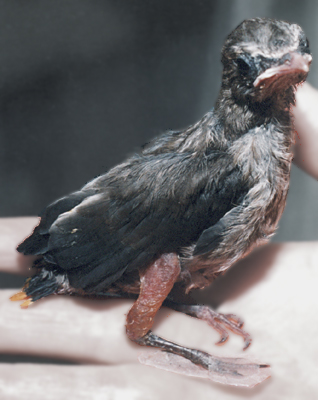 3. Cedar Waxwing,
3. Cedar Waxwing,
now able to use the healed leg and foot,
ready for the aviary
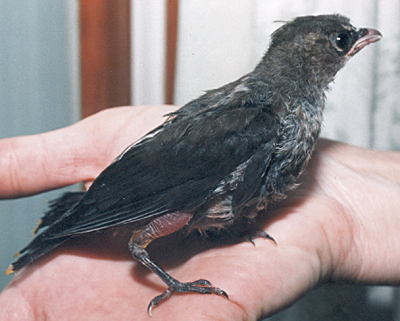
Although we have been able to help many birds like this
one, the path back to health is not easy path for them or us
after the traumatic experiences which have brought them to us.
For example, terrible injuries and strong antibiotics often take
a toll on the normal development of plumage. Here the leg (and
other wounds) have healed, but this bird must now molt and grow
all new feathers in order to survive in the wild.

Helping an Injured Adult
(one photo and some text)
Adult male Cedar Waxwing
recovering from being hit by a car
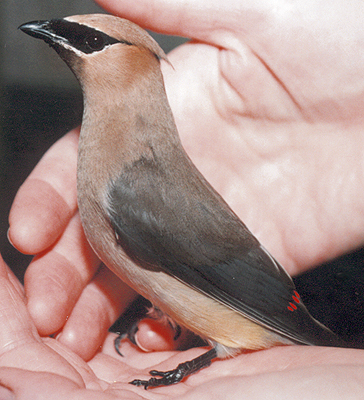
|
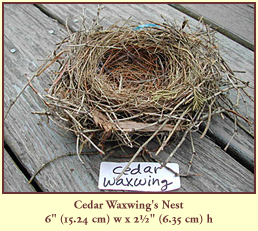 These
quiet, sweet natured birds travel in flocks and eat berries.
Cedar Waxwings exhibit an especially endearing behavior with
each other in the wild: they will sit on a branch in a line,
and pass a berry down the row, from bird to bird, until one swallows
it! This is a species that is gentle in temperament, as well
as beautiful in appearance. These
quiet, sweet natured birds travel in flocks and eat berries.
Cedar Waxwings exhibit an especially endearing behavior with
each other in the wild: they will sit on a branch in a line,
and pass a berry down the row, from bird to bird, until one swallows
it! This is a species that is gentle in temperament, as well
as beautiful in appearance.
Cedar Waxwings nest in trees or shrubs, sometimes in colonies,
and they have been known to line their nests with wool or human
hair. The young are fed insects as well as berries. Waxwings
generally do not migrate but are nomadic and follow the food
supply. This species has a black mask, and striking yellow or
orange tail tips. |

|


|
[Home]
[Whoooo are we?] [the
Story of Baby Birds] [Myths & Misconceptions]
[FAQs] [How you can help] [Photo Gallery] [Contact]
[Donations]
[Shopping]
[Emergency? Click
here.]
This website and all its contents
belong to The Place for Wild Birds, Inc.
Copyright © 2002, all rights reserved. Reproduce only with
permission.
All photographs by Walter S. Bezaniuk. Most illustrations by
Kathleen Frisbie.
Site design and some illustrations by Sara. |
|